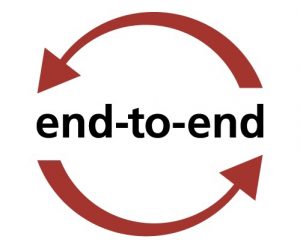15 Aug End To End Thinking

End-to-end is a key concept in technology. Investopedia has the best definition, in my view, on what the term actually means. “End-to-end is a term used to describe products or solutions that cover every stage in a particular process, often without any need for anything to be supplied by a third party. It also embraces a philosophy that eliminates as many middle layers or steps as possible to optimize performance and efficiency in any process.”
Over the past few days, I have been participating in a course on Accelerating Social Transformation (AST2018). The discussions we’ve had with a variety of social sector actors and players such as: Vulcan, Tableau Foundation, Gates Foundation, and Global Good have reinforced my view that end-to-end thinking is a key concept and practice in accelerating social transformation. Those who want to achieve impact, at any scale, must apply this thinking. However, there is one significant distinction, in my view, between this type of thinking in the technology sector and this type of thinking in the social sector.
In technology, the concept often implies delivery “without any need for anything to be supplied by a third party.” In the social sector, accelerated social transformation often happens through strategic partnership and collaboration with many things supplied by third parties.
This is fairly obvious when you think about the differences between delivering a product and creating social change that improves the lives of individuals and communities. However, there is something that seems not so obvious when we get right down to application. The great pitfall can be that end-to-end thinking is a concept and not a practice. Many efforts can be very siloed at the point of implementation, in ongoing operations and in outcome measurement. The result is efforts that don’t help the beneficiaries fully achieve the desired outcome.
Impactful organizations, like the ones we saw this week, highlight the critical nature of “thinking” end-to-end and “working” end-to-end even when your role in the value chain of transformation is very limited or highly specific and specialized. This is not to say everything is perfect inside these organizations. In fact, while they highlight the significant value of end-to-end thinking and working, they also highlight the challenges that exist regardless of the size, scale or scope of the effort.
In my experience, the best end to end solutions for social transformation often involve intimate and nuanced partnerships and collaborations. It is not a matter of resources or money. Neal Myrick, head of Tableau Foundation, said it well, “Philanthropy does not scale.” It is a function of leadership, intention, strategy, and principle. It grows out of an inherit value for human-centered design and a humble recognition of the existence of and value of constraints.
Many of the groups we visited this week for AST demonstrate this way of thinking and working. For example, funders must consider the last mile of their giving. This requires thinking intimately about who is funded, how do they measure success, and how do they engage the community in developing solutions. Innovators in technologies that save lives and improve the quality of life must think about the downstream and upstream impact of their efforts, both positive and negative, on cultural norms like gender equality, on structures and systems that enhance or diminish human dignity, and on economic drivers the lead to sustainability or dependence.
This way of thinking has profound implications on how we all work. The implications are broad. The key take-always for me this week are:
- Measuring outcomes is a challenge for everyone, but it is a mountain we must all continue to climb using both quantitative and qualitative approaches. Solving for this creates a common table of struggle that can bring partners together in strategic ways.
- End-to-end thinking does not eliminate failure, but it does help to ensure the burden of failure is not left with those we seek to serve. It allows us to bear failure and/or set-back in advance of implementation. This is truly a way to respect the dignity of those we serve.
- End-to-end thinking changes our perspective on time. We must consider the totality of the change we seek to achieve as opposed to the timing of our specific time for involvement in a process.
- The question is not whether innovation, growth, or scale are important. It is understanding that the three things are related, but they are not exactly the same.So, it is important to understand which, if any of the three, is relevant for an effort. End-to-end thinking could lead to decisions to sunset, merge, transition, or maintain an existing effort.
- End-to-end thinking and end-to-end acting liberates and constrains us simultaneously. It exposes us to our limitations, and it opens us to the complete value chain needed to achieve the solutions we envision.


